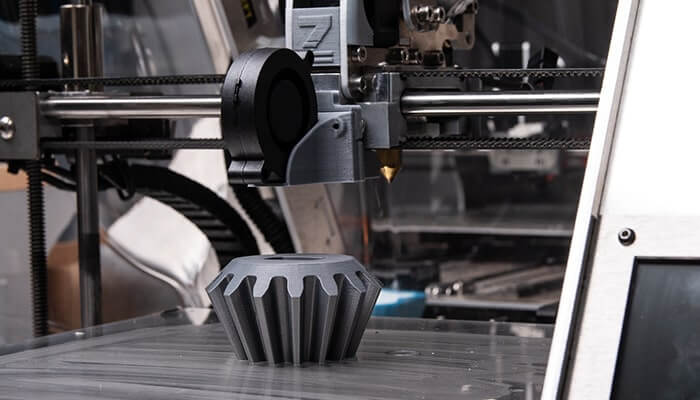
A composite material is a blend of two or more materials with different chemical and physical properties. Upon combination, they aim to serve a specialized purpose: increasing strength, reducing weight, improving electrical resistance, and more.
Engineers often come across problems that call for unique solutions. They usually require multiple improved physical properties like weight, strength, etc. simultaneously.
Unfortunately, many naturally occurring contenders often lack in one aspect or the other. This increases the number of materials needed as well as the cost of procuring them. Add to that the added costs of modifying them according to needs and logistics, and now you have budget issues to deal with.
Composite materials have swooped in and shown immense promise in unifying multiple production and manufacturing sectors. Easily available materials like glass fiber, carbon fiber, and polymers are brought together in a mesh known as a matrix. Many other alternatives like nano-particles and graphene are also widely used in a matrix.
In this piece we aim to cover these aspects of composite materials:
- History
- Composites — The Basics
- Classification based on the matrix material
- Classification based on reinforced material structure
- How to fabricate
- Applications
- Conclusion
Because of their huge potential, the production of composite materials is one of the fastest-growing businesses out there. Many factors make composites the avant-garde of the manufacturing industry. This piece aims to signify the huge role it plays in our present and potentially even bigger in the future.
Let us dig into it.
History
The concept of composite materials first came into existence when over 6000-years ago some Egyptian engineers came together and mashed straw and mud to form bricks. Around a similar era, Mesopotamians in Iraq glued strips of wood on top of each other at various angles to create plywood. During the 17th century, the traditional bows in Mongolia were replaced by composite bows made of horn, wood, and sinew. It was called the ‘Mongol bow.’ The bow was capable of storing more energy than the regular wooden bow of the same length.

Fast forward to the industrial revolution and the rise of polymers and plastic. It led to widespread applications especially due to its high resistance to heat and electricity. The glass fiber resins invented in the 1930s are still a prominent technology in today’s composite market.
But it was the invention of carbon fiber in the 60s that opened up a lot of potential applications of this composite technology.
In the last few decades, scientists and researchers have developed and classified composite materials on multiple bases.
Let us take a look.
Composites — The Basics
Composite materials, by definition, comprise at least two materials. In a combination, each takes up a distinct phase i.e. the matrix phase or the dispersed phase.
The matrix phase
The primary phase with a continuous character is called the matrix. It holds together the dispersed phase sharing a load with it. The matrix is often more malleable and ductile.
The dispersed phase
The secondary phase that is embedded in the matrix in a discontinuous form is the dispersed phase. Since it is often stronger than the matrix, it is recognized as the reinforcing phase.
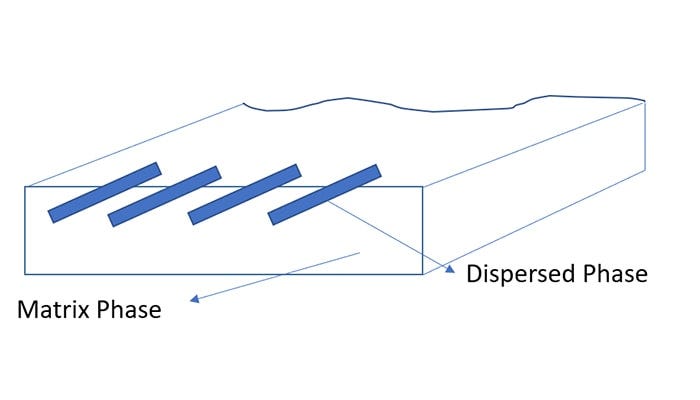
Now the classification of composites is largely based on the materials of the matrix phase and the dispersed phase. In the next section, we will classify composites based on matrix material and reinforced material structure.
Classification based on the matrix material
- Metal Matrix Composites MMC
- Ceramic Matrix Composites CMC
- Polymer Matrix Composites PMC
Metal Matrix Composites MMC
As the name suggests, the matrix of this composite material is made from metal. A lighter metal is preferred for structural applications, like aluminum, magnesium, or titanium. This provides compliant support for the reinforcement and the structure as a whole.
The image below of a turbofan is manufactured out of MMC material. It is lightweight which helps in improving the fuel efficiency of the aircraft.
Ceramic Matrix Composites CMC
In this type of composite, ceramic fibers are embedded in a ceramic matrix phase. This type of structure overcomes the low crack resistance problems faced by conventional ceramic structures. Materials like Carbon, Silicon Carbide, Alumina, etc. are prime candidates for the matrix and dispersed phase both.
In the image below the shaft sleeves for big pumps were manufactured using SiC-fibre reinforced SiC material via chemical vapor infiltration.
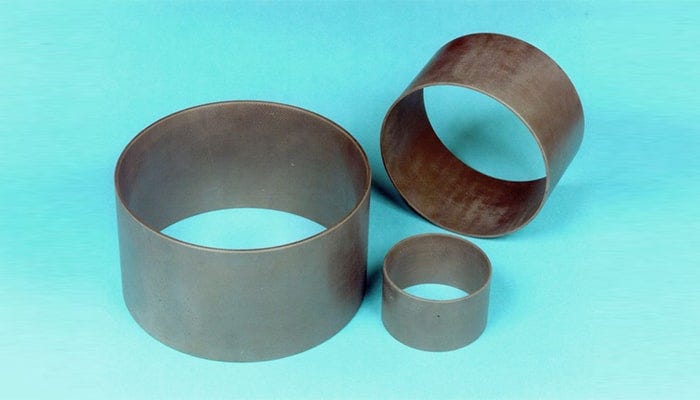
Polymer Matrix Composites PMC
This type of composite consists of polymer matrices that bind together various short or continuous fibers. The matrices are most often thermosets of resin systems like epoxies, phenolics, and polyamides. PMCs are known for their lightweight, high stiffness, and high strength.
Classification based on reinforced material structure
- Particle-reinforced composites
- Dispersion strengthened
- Particulate
2. Fiber-reinforced composites
- Continuous fiber.
- Discontinuous fiber
3. Structural Composites
- Laminar
- Sandwich structure
Particle-reinforced composites
These are one of the most widely used classes of composite structures due to their ease of availability while being economical. They can be further distinguished based on the strengthening mechanism — particulate and dispersion-strengthened.
- Dispersion strengthened
In this case, the size of the particles is comparatively smaller, ranging from 0.01 to 0.1 um. The strengthening occurs at the atomic and molecular level similar to that of precipitation hardening in metals.
Examples: Thoria (ThO2) dispersed Nickel alloys have high-temperature strength. Sintered Aluminium Powder (SAP) — where minute flakes of alumina are dispersed on an aluminum matrix. - Particulate
This class of composite contains relatively large amounts of coarse particles. They are often designed to produce unusual combinations of properties rather than necessarily improve them. They can be used with all three matrix types — MMC, CMC, and PMC.
Examples: Tungsten Carbide or Titanium Carbide embedded with cobalt or nickel is used to make power-cutting tools.
Fiber-reinforced composites
Fiber-reinforced composites provide improved mechanical properties such as strength, strength-to-weight ratio. It incorporates strong, stiff but brittle fibers into a softer, ductile matrix. The matrix acts as a medium to transfer the load to the fibers that do the majority of heavy lifting.
They are further classified as either continuous or discontinuous fibers.
Continuous fiber-reinforced composites
In continuous fiber composites, the length of the fibers can vary from a few feet to several thousand feet long. A large advantage is that by allowing a uniform orientation of the raw composite fiber, important design criteria (strength, Y-modulus, CTE) can be enhanced and customized.
As a whole, continuous fiber composites tend to be more expensive than their short, discontinuous fiber counterpart. But it makes up for it by providing significantly improved performance.
Discontinuous fiber-reinforced composites
This sub-division of composites is further broken down into two sub-sub-divisions. They are discontinuous aligned fibers and discontinuous randomly oriented fibers.
- Discontinuous aligned fiber composites have shorter lengths of highly condensed fibers aligned in one fixed direction in a matrix. They can demonstrate mechanical properties comparable to those of unidirectional continuous fiber composites. But the shorter fibers result in diminished ductility of the composite, making them ideal for high-strength, low ductility applications.
- Discontinuous randomly-aligned fiber composites are made up of short, condensed fibers embedded in all directions of a matrix. Aligned fiber composites have heightened mechanical properties in only the direction of the reinforcement. This anisotropy can be avoided by randomly embedding the fibers equally in all directions of the matrix. While this may result in decreased peak strength, it provides increased formability at a reduced cost.
Structural composites
Structural composites are a special class of composites. Their properties depend not just on those of the constituents but also the geometrical design of various structural elements. Two classes of widely used structural composites are — laminar composites and sandwich composites.
- Laminar composites are composed of two-dimensional sheets/layers that have a preferred strength direction. According to specific needs, these layers are stacked and cemented together. Materials like metal sheets, cotton, paper, and woven glass or carbon fibers are embedded in a plastic matrix.
Thin coatings, thicker protective coatings, claddings, bimetallic, and laminates are some examples of Laminar composites - Sandwich structures consist of thin layers of a facing material joined to a lightweight filler core material. Each of the individual materials has either high strength or (directional) rigidity, and the composite possesses both of those properties.
The core separates the faces resisting deformations while providing a degree of shear rigidity along the planes perpendicular to the faces.
Typical face materials include Aluminium alloys, fiber-reinforced plastics, titanium, steel, and plywood. While the core materials are often foamed polymers, synthetic rubbers, inorganic cement, aluminum honeycomb, and balsa wood.
Composites — How to fabricate
Fabrication of composite materials often includes wetting and mixing the reinforcement with the matrix. It then goes through a heat or chemical reaction to bind them into a rigid structure. Preset molds are formulated according to various characteristics like the type of materials used, the order and ways of introducing material, the required constituents, and more.
It is achieved by a wide variety of methods (for fiber-reinforced composites), such as:
Conventional Methods
- Wet-layup
- Filament winding
- Pre-preg layup (Can be manual or automated)
- Resin transfer molding (or modified, like VARTM) [Can be used for chopped fiber composites as well]
Modern Methods
- Advanced fiber placement
- Fiberglass spray lay-up process
- Z-pinning
Let’s have a look at a few of these.
Wet Layup
Possible the oldest and still most widely used process for composite fabrication, the wet layup is done by simply laying down the reinforcement material on the mold, and pouring / mixing / applying the resin material on it using a brush, or roller, or even hand.
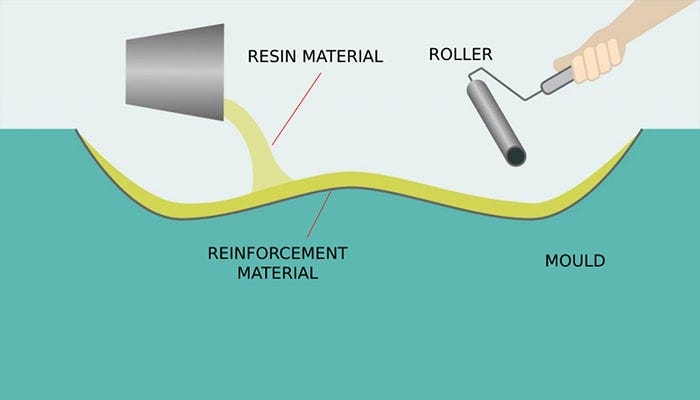
Filament winding
This technique is mostly used for manufacturing open-end structures such as cylinders. Filaments are wound under tension over a rotating mandrel. Glass and carbon are the most common filaments which are impregnated with resin as they wind onto the mandrel.
As with the advanced fiber placement method, the angle of the fiber wound affects the properties of the final composite.
Pipes, bicycle spokes, power poles, aircraft fuselages, rocket ignitors, lamp posts, and so on are the applications where filament winding is fast finding a home.
Advanced fiber placement
This can be said to be the 3D printing of a continuous fiber composite. One of the more advanced processes, its claim to fame is offering lighter materials with equivalent or greater strength than metals.
It is an automated process where synthetic resin-impregnated fibers are heated on complex tooling molds. A few bundles of carbon fibers impregnated with epoxy resin are fed to a heater and roller on the Fibre placement machines. The angle of placement of these bundles is determined according to the type of fiber-reinforced composite required.
Fiberglass spray lay-up process
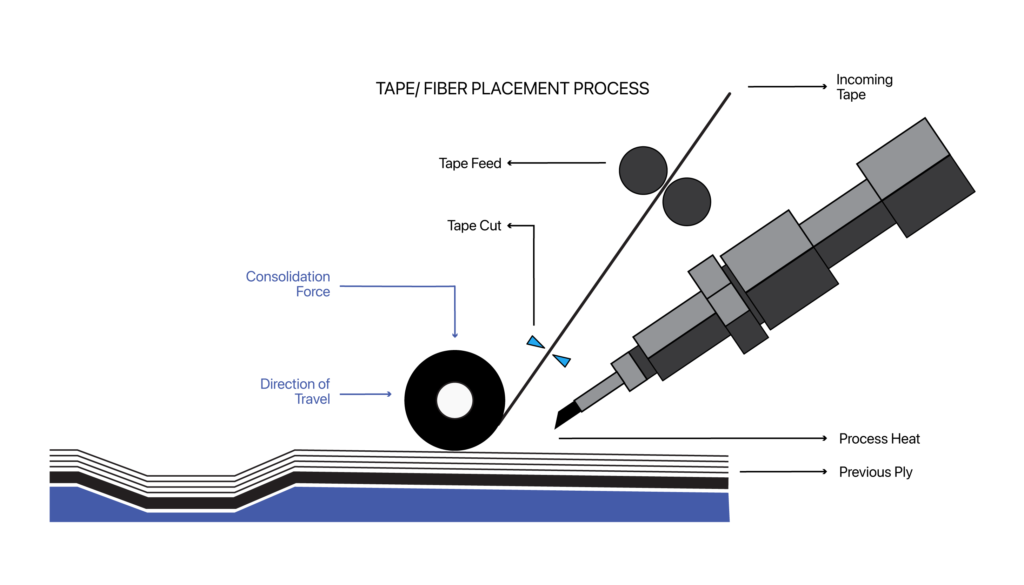
This method, also called the chop process, conjures fiberglass objects by spraying strands of glass out of a pneumatic gun.
It is an open-molding process where resin and reinforcements are sprayed onto a reusable mold. The spray-up is used to compact the laminate following which a secondary spray-up layer embeds the core between the laminates.
This is one of the most economical processes when it comes to the production of small to medium volume parts.
Z-pinning
True to its name, it is a technique that inserts reinforcing fibers along the Z-direction of the plastics. Metals are the preferred choice of fibers for this method.
It can dramatically improve the strength and durability of several materials, especially an increased resistance to delamination. It has found a niche in the automotive and aircraft industry, because of its ability to perform under high-pressure conditions.
There are many more methods that are used for composite fabrication. These are mostly some variations or a mix of the above-mentioned methods.
Applications
The digital revolution of the last few decades has substantially altered the perception of technology. The possibilities of applications seem boundless with every new day.
The advances in the composites market and its manufacturing technologies have seen a surge in its range of applications. Sectors like aerospace, drones, construction, corrosion-resistant equipment, consumer appliances, and more.
Drones
In just a few years, drones have found applications from surveillance to food delivery, photography, surveillance, etc. The payload of the drone has a huge impact on flight time and power usage. To improve the weight reduction of UAVs composite materials play a crucial role in the design and manufacturing of drones. They are capable of substituting conventional materials like Aluminum which is a convenient option for drone fabrication but causes higher overall weight.

Aerospace

The lightweight and high specific strength is a huge plus if one wants to dominate the aerospace industry. Add to those characteristics like fatigue and corrosion resistance, a higher degree of optimization, and potentially economic, composite materials fit like a glove.
The image above depicts the overall composition of materials used in a typical Airbus 350. 53% of the materials account for the use of composite materials.
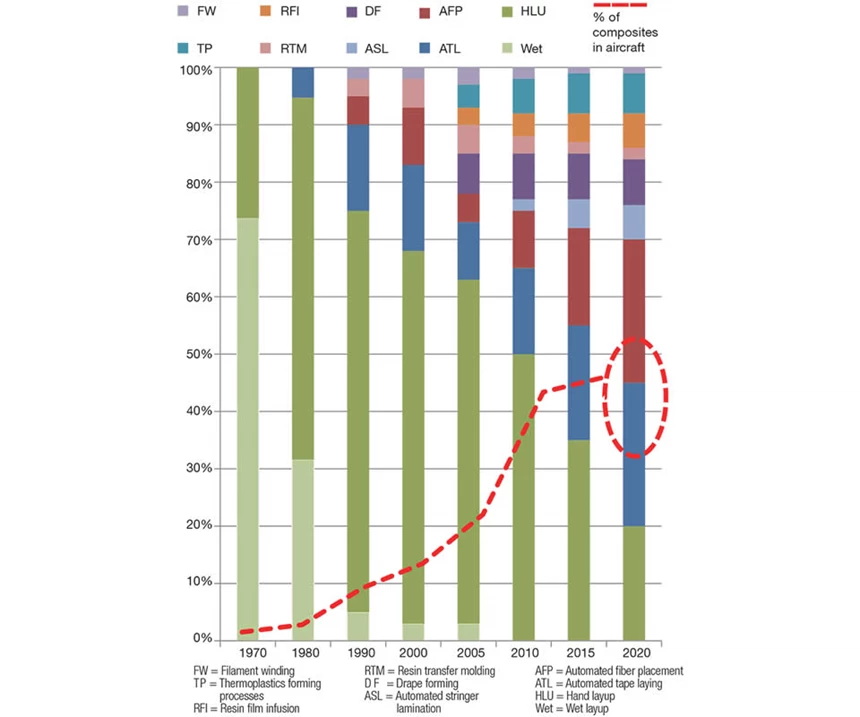
According to the above graphic, the last half a century has seen a massive shift in the methods of production of aircraft parts. The red dotted line depicts the % of composites used in an aircraft. Nearly 80% of an aircraft in 2020 uses a composite material of some kind, compared to about 5% in the 1980s. AFP (Automated fiber placement), ATL (Automated Tape Laying), Wet (Wet layup), filament winding (FW), HLU (Hand layup), and other fabrication processes are mentioned in the legend.
Construction
The civil and construction business has found a home for composite materials for a long, long time. Cladding, drywalls, furniture, building core, and foundations have all been aided by the versatility of composite material
Fiber-reinforced plastic composites possess high tensile strength, fatigue resistance, low mass, etc., which are ideally requisite for a civil engineer.
Floors, bearing pads, concrete structures influx with steel plates or bars in a sandwich structure, beams and bars, wood panels, are a few examples of composite presence in the construction arena.
Sports
In 2021, there are hardly any aspects of life that are untouched by the composites. An interesting area where it has taken a stronghold is sports and recreation. From racing helmets and protective gear to tennis rackets and hockey sticks. You would be hard-pressed to find a sport where composites have failed to rear its head in
Consumer appliances
Electronic appliances like phones, home appliances, insulator boards, component systems, circuit breakers, lighting devices, insulated wires, etc. all contain composite materials in some form or another.

Conclusion
With every passing day, the composite industry is becoming more and more lucrative. The global composite market is seeing a 5% growth every year, while carbon fiber demands are scaling up at 12% a year.
To sum up, a composite material is a blend of two or more materials with different chemical and physical properties.
With applications ranging from aerospace and automotive to healthcare and electronics, from paper-mache articles to skyscrapers, composites have taken over the world.
If you are looking for an alternative material for your dream manufacturing project, a part-time start-up, or just a hobby in the garage, there is likely a composite that fits your needs.
Now, we would like to hear from you.
Has a composite material ever saved the day for your project? Tell us all about it in our comments section.
For more solutions on composites and other manufacturing technologies, visit our website fabheads.in
